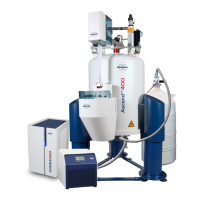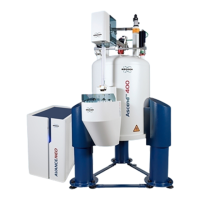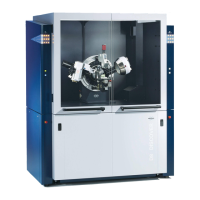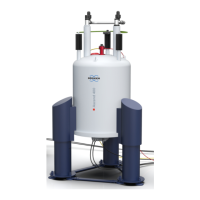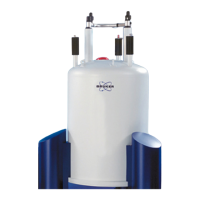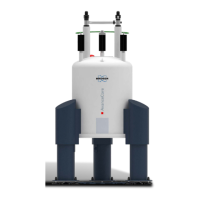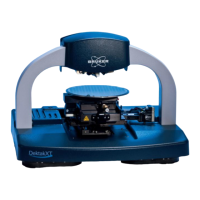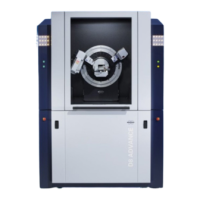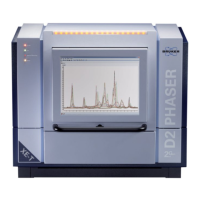Installation
H157655_1_008 99
11.4.2 Magnet Evacuation and Flushing with Nitrogen Gas
Once the magnet has been assembled and placed in the magnet room, rough pumping of the
cryostat can begin. At the same time the cryostat is flushed through with dry nitrogen gas.
The customer must provide a 50l (4.6 grade)/200 bar (~2 cu.ft, 3000 psi) cylinder of dry
nitrogen gas (99.996% purity). The cylinder should be fitted with a secondary regulator valve
to deliver a pressure of 0.5 bar (~8 psi).
Further pumping of the cryostat is carried out by a turbo pump to reduce the internal
pressure.
11.4.3 Cooling the Magnet to Liquid Nitrogen Temperature
This next stage involves filling the magnet with liquid nitrogen. The quantity of liquid nitrogen
required is listed in the table in the Charging the Magnet [} 99]. The transfer dewars used
for precool generally have a capacity of 250 - 500 liters (attention: maximum pressure < 0.5
bar) with a fixture for pressuring and transferring via a stainless steel or corrugated plastic
tube of 10 mm (~3/8”) diameter.
11.4.4 Cooling the Magnet to Liquid Helium Temperatures
For this procedure, the customer must provide the following:
• A cylinder of helium gas: 50l (4.6 grade)/200 bar (~2 cu.ft, 3000 psi), 99.996%, with
secondary regulator value to deliver pressure of max 0.2 bar (~3 psi).
• Quantities of liquid helium as specified in the table found in Charging the Magnet [}99].
• Liquid helium dewar: 250 - 500 liter capacity, with NW25 flange or suitable outlet
compatible with the 10 mm (~3/8").
When ordering the helium the customer should arrange to have it delivered immediately
before cooling the magnet to liquid helium temperature. If delivered to the site much earlier,
losses due to evaporation will occur and must be taken into account (usually 1% of nominal
volume/day).
11.4.5 Charging the Magnet
The final stage involves bringing the magnet to field. This will take 1-3 days depending on the
magnet type. During charging there is a possibility for the magnet to experience a quench.
The quantities of liquid helium for final cool down and energization/cryoshimming as well as
extra liquid helium required after one quench are specified in the table below. The customer
is required to provide the cryogens needed for the complete installation including up to two
training quenches.
The values of liquid nitrogen and helium in the table below are the minimum requirements. An
extra 20-30% of each is advisable, particularly as many suppliers will take back unused
cryogens.
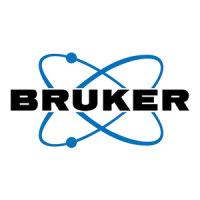
